With Tesla Motors, PayPal and SpaceX founder Elon Musk and inventor JB Straubel intend to speed the conversion of cars from gasoline to electricity by applying the mindset and methods of Silicon Valley. Over the past decade they've endured plenty of setbacks--automotive engineering proved more complicated than originally expected--and countless critics. Just a few years ago rival Fisker was reaping all the buzz. Today, though, Fisker is all but gone while Tesla has reported its first quarterly profit and repaid its government loans nine years early. But the Model S is only in its first model year, and supply remains short of demand by early adopters. Does the car have what it takes for long-term success?
Note: Tesla does not have a media fleet. Instead, they suggest that reviewers visit a dealer for a test drive. This review is not as thorough as it would have been with more time in the car.
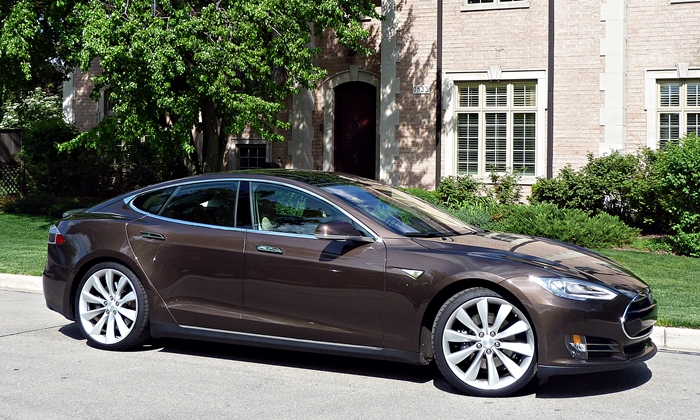
Long hood suggest a large, powerful engine--but the motor is actually in back. more Model S photos
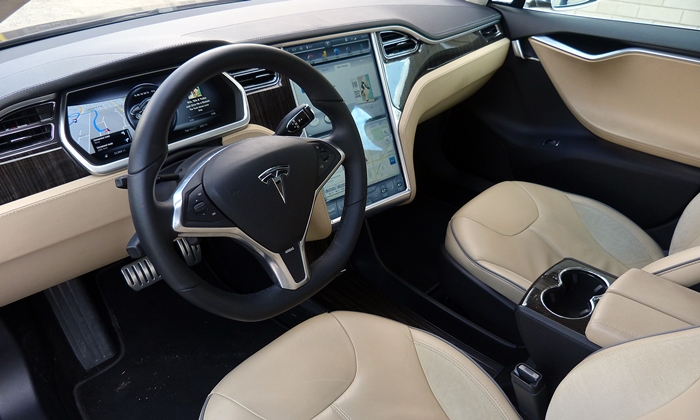
Unfinished or just clean?
| |
Compared to the A7 |
| Fuel economy |
 Better
Worse
Better
Worse
|
If the Tesla Model had a conventional gas-powered engine, few people would care about it. Plenty of established companies offer stylish, powerful, and luxurious sedans. Why place a $70,000+ bet on a new car from a new company?
The reason just about everyone (and their mom) has heard of this upstart car company and its first completely in-house product is that the Model S, with its battery-powered electric motor, was engineered to render conventional cars passe. For anyone who must have the latest tech, it is the car to get.
Two battery sizes are offered, 60 kWh and 85 kWh, the latter an additional $10,000. (A 40-kWh battery--actually a 60-kWh pack electronically limited to two-thirds of its capacity--was initially offered, but few early adopters opted for it and it has been discontinued.) The EPA rates the former for the equivalent of 94 mpg city, 97 mpg highway, the latter for 88/90. For reference, the much smaller, far less powerful Nissan LEAF is rated 129/102, considerably better in city (actually suburban) driving but not much more efficient on the highway. Among gas-powered competitors, the Audi A7 is rated 18/28 and the more powerful S7 is rated 17/27.
Tesla's big advantage over other electric cars involves their shared primary limitation, range. In EPA testing, the LEAF's range was 75 miles, and other electrics in its price and size range manage about the same. In the same test, the two Model S packs achieved 208 and 265 miles, respectively. (Note: Range is significantly shorter for all electric cars in cold weather or when running the A/C.)
Consider cost per mile, and the Tesla's fuel economy seems even better. At the national daytime average of 12 cents per kWh, the cost per mile is about four cents. (Charge at night, when rates are often discounted, and it's even less.) In comparison, an Audi A7 or S7 has a fuel cost of nearly twenty cents per mile. The average driver can save over $2,000 a year by driving a Model S.
The major downside of the Tesla's electric powertrain (beyond purchase price) is the time required to charge its battery pack. With twin onboard chargers ($1,500) and a high-powered wall chargers ($1,200 plus installation) each 62 miles of range requires an hour. Easily practical for typical daily driving, but not for long-distance travel.
For long-distance travel, Tesla is building a network of "Superchargers" and battery swapping stations. The Superchargers can provide half a full charge in 20 minutes. Free use of these is a $2,000 option with the regular pack and included in the price of the larger one. You'll be able to have the battery swapped in as little as 90 seconds. But the swap will cost $60 to $80 and you'll have to stop on the return trip to have the original pack re-installed or pay an additional charge. These stations will make long-distance travel feasible, but it will still be less convenient and/or more expensive than in a gas-powered car.
| Powertrain performance |
 Better
Worse
Better
Worse
|
Many people expect the Tesla Model S to be fuel efficient. What they often do not expect is that, with a 416 horsepower motor, the Performance variant can get to 60 mph in just over four seconds--nearly as quick as the quickest gasonline-powered competitors. Step down to the regular 85-kWh model (362 horsepower, 5.4 seconds to 60) or even the base pack (302 horsepower, 5.9 seconds to 60), and the Model S remains plenty quick. But even these impressive numbers don't do justice to the experience of driving the Model S. With no gears to downshift through or emissions to control, the powertrain can deliver its peak torque almost instantly, and with virtually no noise. Want to change lanes, and spot a hole? Just point and shoot. You can't get the same sensation with an internal combustion engine, no matter its peak power.

Yes, it's a big hatchback, but much prettier than those from BMW and Porsche.

Displays dominate a button-free instrument panel.
| Cargo capacity |
 Better
Worse
Better
Worse
|
Tesla's first car, the Lotus Elise-based Roadster, also delivered both performance and efficiency. But I was never terribly impressed by the Roadster because it was based heavily on someone else's car and, as a roadster, it avoided the complicated trade-offs inherent in more practical body styles. (Granted, I might have been more impressed if I had driven one.)
With the Model S, we have a car entirely designed and engineered by Tesla, and a large four-door to boot. Four-door cars aren't necessarily practical. Just check out the cramped Fisker Karma. At 196 and 77 inches, respectively, the Model S is about as long and wide as a Karma (and a little larger than an Audi A7). But thanks to a height dictated by engineers rather than designers (56.5 vs. 52.4 inches), much more efficient packaging, and an airy interior design, the Model S feels far roomier than the Karma, and even somewhat roomier than the Audi, especially in the back seat. Where the Karma's 20-kWh battery pack occupied a massive center console that ran the length of the interior, the Model S's more numerous cells occupy a four-inch-thick layer entirely beneath its flat floor.
The great majority of cars this large are sedans, with trunks. To play it safe, Tesla could have offered the same. Instead, the Model S is a hatchback, with much better access to its cargo area. The official specs of 26.3 cubic feet with the rear seat up, 58.1 with it folded, are a little better than the A7's despite the location of the motor and inverter beneath the cargo floor. With no need to fit a powertrain up front, there's a second cargo area beneath the hood. This "frunk" appears larger than its 5.3 cubic foot spec suggests and is usefully deep.
But wait, there's more! For $1,500 Tesla will add a rear-facing third-row seat, suitable for carrying a pair of children. Such seats used to be fairly common in large wagons, but I've never seen one in a hatchback. With this seat, the Model S can carry seven passengers, as many as a minivan. Want a third row capable of carrying adults? A Model X crossover is on the way.
A couple of nits: interior storage compartments are small, and there's no second-row center armrest.
| Exterior styling |
 Better
Worse
Better
Worse
|
The Model S might not be as over-the-top sexy as a Karma, but it is nevertheless a highly attractive car, perhaps on par with the Audi A7 depending on one's taste. Potential buyers won't be avoiding this large hatch like they do the BMW 5-Series GT. The major aesthetic weakness could be a lack of distinction, as the exterior borders on generic.
The interior styling is much more distinctive. Depending on one's perspective and expectations, it can seem either not quite finished (more prototype than production car) or extraordinarily clean. Though just about every surface is upholstered and French-stitched, what really grabs the eye are a pair of displays, a large LCD for the instruments and a huge, 17-inch touchscreen for virtually all of the secondary controls. There are no actual buttons on the instrument panel. Even the large panoramic sunroof must be opened and closed via the iPad-like touchscreen (which, to its credit, lets you specify a percentage). While these unconventional controls do entail a fairly steep learning curve, they are highly configurable and comprehensive. Most of the virtual buttons are large, and responses are generally lag-free (if also tactile feedback-free). The largest downside might be the potential for distraction, as you can load entire web pages. Updates can and will be made to the car's software via a 3G link--no need to visit the dealer.
The steering column control stalks are supplied by Mercedes-Benz, but not that company's latest. As a result, the top left stalk operates the cruise control rather than the turn signals. As in Mercedes, I sometimes engaged the cruise when attempting to signal. Hopefully they transition to Mercedes-Benz's new stalks, with the turn signal in its conventional location, soon.
| Handling |
 Better
Worse
Better
Worse
|
With its heavy battery pack entirely beneath the floor and its body almost entirely composed of aluminium, the Tesla Model S has a low center of gravity. Combine this low center of gravity with a slightly rear-heavy weight distribution and excellent suspension tuning, and the Model S carves curves with minimal lean, good balance, and excellent composure despite its 4,650-pound curb weight (about 400 over an Audi A7 and 100 over an Audi S7, both of which are all-wheel-drive). The steering is quick (even too quick at highway speeds) and weights up naturally as the wheel is turned, but (like most luxury car systems) provides very little feedback. In sport mode the steering feels a bit heavier, but still not as heavy or as direct-feeling as an Audi in "dynamic" mode. I didn't disable the traction control during my test drive, and the stability control system cannot be turned off. Perhaps for this reason, power was limited in turns. Overall, I found the Model S to be responsive and highly competent, but--like most cars of its size and weight--not engaging. The Audi A7, though more firmly sprung, is little better on the last count.
An Audi S7 might be considerably more fun to drive along a curvy road than the Model S, but I haven't yet driven one. Elon Musk was disappointed to learn that the Model S didn't handle as well as a McLaren supercar, and directed Tesla's engineers to develop a sport suspension. The resulting Performance Plus Package is now available, but costs $6,500 (on top of $3,500 for the 21-inch wheels, for a total of $10,000). This seems steep for better suspension tuning and grippier tires, as it's at least five times the company's cost. The upgraded suspension allegedly also rides more smoothly. It's a shame that they don't simply make the sport suspension standard, with just the grippier, more expensive Michelin tires optional. Sure, Tesla must turn a profit, but after the early adopters get their cars how many people will pay $6,500 for this package?
| |
Compared to the A7 |
| Price or payments |
 Better
Worse
Better
Worse
|
The cars I drove, the 416-horsepower Tesla Model S Performance and 310-horsepower Audi A7, aren't directly comparable. The 420-horsepower Audi S7, not yet driven, would be more appropriate. With metallic paint and 20-inch wheels, An S7 lists for $81,170--far from cheap. But even after a $7,500 tax credit (for which some people are not eligible) a comparably equipped Model S lists for $99,270--$18,100 more. Adjust for remaining equipment differences and the gap widens to $22,000.
The Model S is a much better value if you don't opt for the top spec model. Tesla charges $12,000 more for the Performance variant on top of its additional standard content (which includes $10,000 for the larger battery pack). Unless you must be able to get to sixty in under 5.4 seconds (the primary benefit), I'd pass. Step down to the 60-kWh Model S and compare it to the Audi A7, and the respective sticker prices change to $72,270 vs. $67,520, a mere $4,750 difference. Though adjusting for feature differences nearly doubles this, the resulting $8,900 gap is much smaller than in the Model S Performance vs. S7 comparison.
Note that these price comparisons do not include the additional cost of a second onboard charger or of any high-powered wall chargers. These could add another $4,500 to the price of the Model S.
| Feature availability |
 Better
Worse
Better
Worse
|
The feature adjustment is over $4,000 when comparing the Model S to an Audi because many features commonly offered on luxury cars aren't available on the Tesla. On the performance front, you cannot get all-wheel-drive, at least not yet. This plus the lack of a geared transmission account for half of the difference. But this still leaves a couple grand. Features offered on the Audi but not the Tesla include cooled front seats, automatic climate control for the rear seats, adaptive cruise control, and a slew of safety nannies. Though you can get a rearview camera on the Tesla, you can't get obstacle detection. The feature some people will miss most: illumination for the visor mirrors.
Other missing features would benefit efficiency. Unlike in a Prius, Tesla drivers must do without detailed driving style feedback or a way to vary the sensitivity of the accelerator. (A highly responsive accelerator can make a car seem quicker, while a highly unresponsive one makes it easier to maximize efficiency.) Perhaps future software updates will provide one or both features.
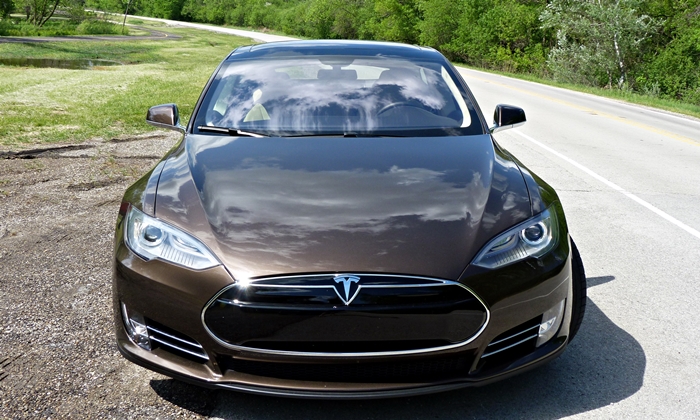
Sleek and mildly sporty face, but is it sufficiently distinctive?
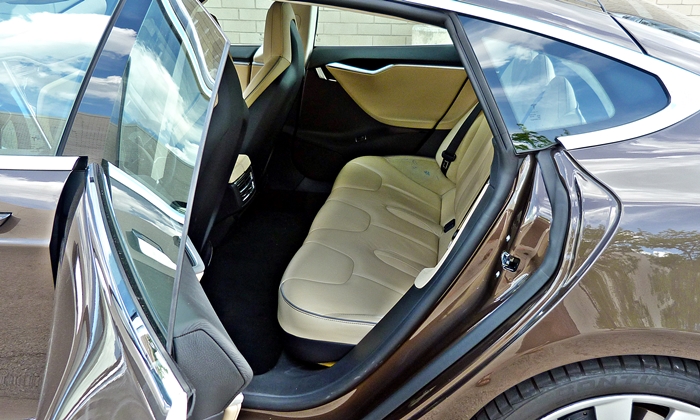
Wide, roomy seat and flat floor. But no center arm rest or cupholders for rear seat passengers.
| Quietness |
 Better
Worse
Better
Worse
|
Around town, the Tesla Model S is a very quiet car, with virtually no powertrain noise. You do hear and feel the $3,500 low-profile 245/35YR21 tires work their way over bumps and chuckholes--the standard tires should be smoother and quieter. On the highway, there's more road noise than you'll hear in some competing luxury sedans. An Audi isn't significantly quieter, but a BMW, Cadillac, or Lexus is. People who are sensitive to road noise, and who are used to one of the quieter cars, might find the Model S a bit loud at speed. The windows on the demo car also creaked against their seals over uneven pavement.
| Front seat support & comfort |
 Better
Worse
Better
Worse
|
The front seats in the Tesla Model S are reasonably comfortable, but don't look or feel especially luxurious and provide little lateral support in turns. At least in the Performance model the side bolsters should be larger and/or adjustable. The seats in the A7 similarly need more aggressive bolsters. The seats in the S7 have them.
| Materials & workmanship |
 Better
Worse
Better
Worse
|
Interior materials are good, but not great, considering the price of the Tesla Model S. Even with fewer upholstered surfaces, an Audi interior seems richer, more finely detailed, and more precisely assembled.
| |
Compared to the A7 |
| Reliability & durability |
|
As I write this, the Tesla doesn't have a bad reliability record. It just has a lot of new technology, and no reliability record. The standard warranty is 4 years, 50,000 miles, with the option to double this for $2,500. The standard battery warranty is eight years.
Electric cars, with no engine and transmission fluids to change, have far fewer systems to maintain. Even so, Tesla initially required a $600 annual inspection to maintain the warranty. It has recently backed off this requirement, though it continues to recommend the service contract for free roadside assistance, wear items like brake pads and wiper blades, and any necessary hardware upgrades. (It's not clear what the last might include.)
The company-owned dealership included a number of interesting and informative displays, including a bare chassis. Pleasant staff seemed well-educated about the car.
Highly impressive for a new company's first complete car, the Tesla Model S does just about everything well, even very well. Though powered by electricity, it meets or beats the best conventional cars on their own terms. The main downsides are cost, the inconvenience of recharging while traveling, limited feature availability, and unproven reliability. If Tesla can bring the cost down over time--and profitability at the current volumes suggests that it should be able to--then the car and company should have a bright future. Want to have one while the tech is still new, and the price and unknown reliability don't scare you? Then Tesla is ready to take your deposit towards a delivery in two to three months.
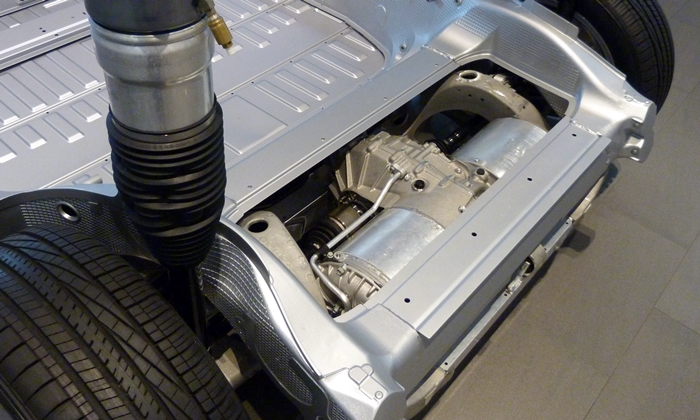
Powerful motor fits beneath the cargo floor.
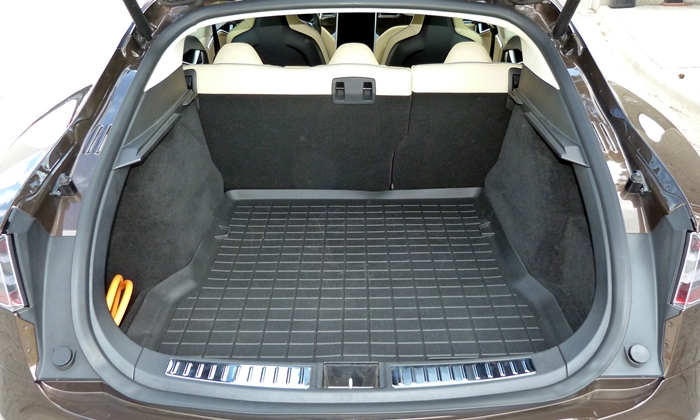
Hatchback provides easy access.
See more 2013 Tesla Model S photos
A company-owned Tesla dealer provided the car for a test drive.











